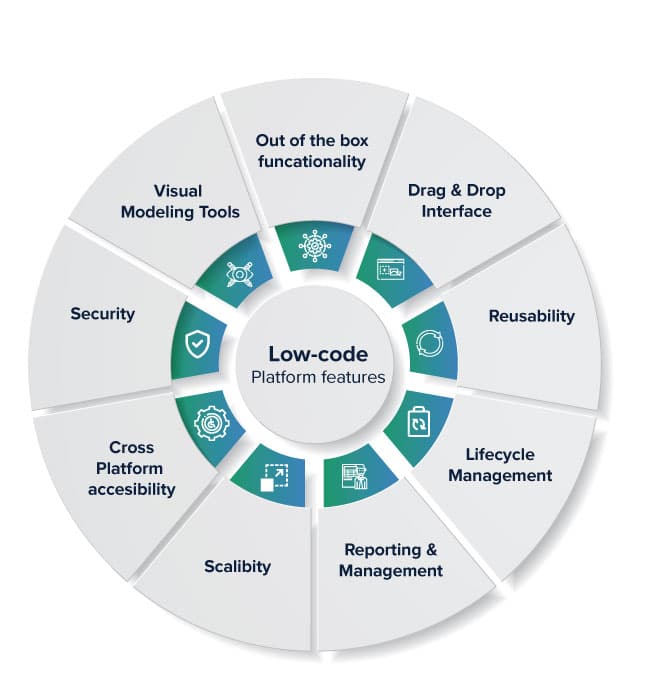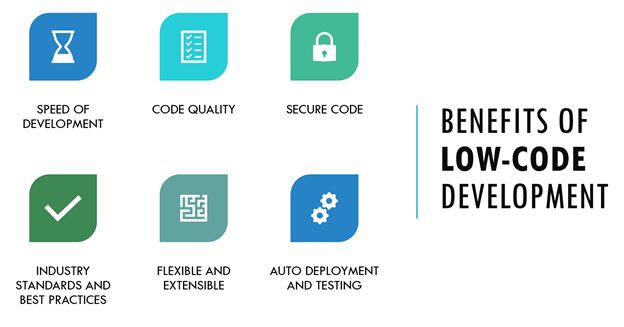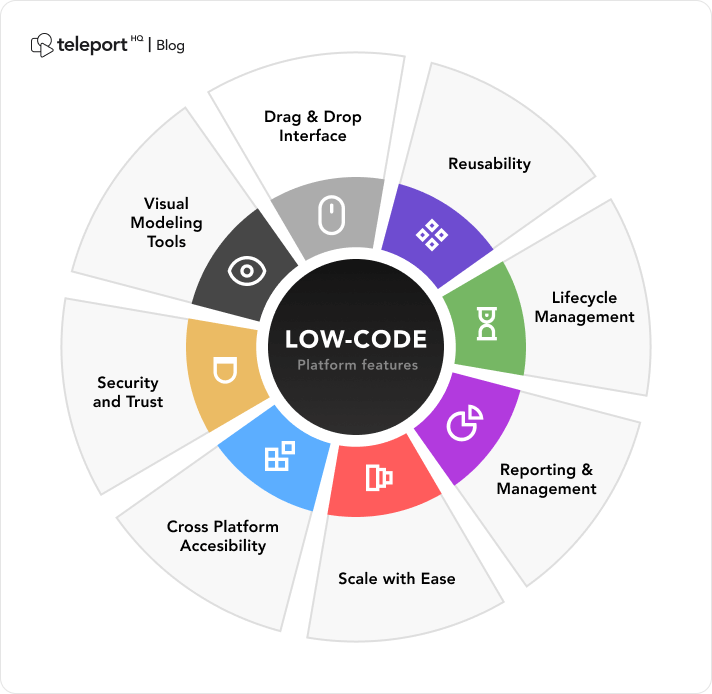Great News On Deciding On Low-Code Platform Examples
Wiki Article
In Terms Of Speed Low-Code Applications Have Many Advantages.
Visual Development Environment:
Drag-and-Drop Interfaces: Low-code platforms provide visual tools for designing applications. Drag-and-drop tools allow developers to rapidly assemble applications without writing code.
Templates and Components that are pre-built: A lot of platforms that offer low-code support include templates and components pre-built, allowing developers to prototype quickly and build applications without needing to start completely from scratch.
Reduction of Coding Requirements
Automated Code Generation Low-code platforms automatically generate the underlying code based on the visual models developed by programmers. This helps reduce manual code, and speeds the process of developing.
Reusable Components: Developers can reuse components from different projects, thereby reducing the time spent writing and testing codes.
Collaboration can be made easier.
Low-code development platforms are typically equipped with tools like version control, deployment and testing. This enables seamless collaboration across teams.
Citizen Development: Business users as well as non-developers are able to contribute to application development using intuitive interfaces, thus reducing bottlenecks often caused by limited accessibility of professional developers.
Rapid Iteration & Prototyping
Rapid prototyping: Designers can quickly design prototypes in order to collect feedback and confirm ideas, resulting in faster cycles of iteration.
Easy Modifications: The visual design of low-code programming makes it simpler to make updates and changes to applications. This speeds up the process of refining and improving applications based on feedback from users.
Pre-built Integrations:
API Integrations: Platforms that are low-code usually come with pre-built connectors for well-known APIs and services making it easier to integrate external systems.
Data Integration: The built-in tools make it easier for connecting to databases and other sources, accelerating development.
Deployment, scaling and deployment:
One-Click Installation: A lot of low code platforms offer a single-click installation option which reduces the amount of work and time needed to install applications.
Cloud-Based Solution: Cloud based low code platforms are able to handle the management of infrastructure and scale. This allows developers to concentrate on functionalities, application logic and features instead of the logistics of deployment.
The efficiency of developing low-code applications is in its ability to simplify and automate various aspects of the application development. This allows quicker delivery of applications and faster adaption to changing requirements. Take a look at the best her explanation for Low-code Platform for application development for more examples including low code platforms, paas service, application development platforms, app dev platform, develop mobile application, rad development, low code development platforms, application modernization software, app modernisation, cross platform mobile development and more.

Benefits Low-Code Apps In Governance And Safety
Low-code application development offers a variety of advantages for governance and security. This is essential to ensure that apps comply with the laws, are safe and well-managed over their lifespan. Here are a few of the most important benefits:
Unified Management Console (UMC): Low-code applications typically provide a centralized management console where administrators can oversee and manage all applications, ensuring consistent governance across the company.
Role-Based Access Control RBAC (RBAC). These platforms often include robust access control based on roles, allowing administrators the ability to define and implement their own access policies. Only authorized users are able to alter or access specific areas of the program.
Compliance and Regulatory Adherence
Many low-code platforms come with built-in compliance features. These are designed to ensure that the applications are compliant with industry standard (e.g. GDPR, HIPAA). These platforms provide frameworks and tools to make sure that the application is in line with these requirements.
Audit Trails and Logging: Complete logging, audit trails and logs are usually integrated into companies that allow them to keep track of changes and track access. They can also make sure that the organization is in compliance with both external and internal regulations.
Additional Security Measures
Data Encryption. Low code platforms typically offer built-in encrypted data when in transit as well as when in rest. This helps protect sensitive information.
Security Certifications: Many low-code providers have security certifications (e.g., ISO 27001, SOC 2) that demonstrate adherence to high security standards, offering extra security for users.
Automated Security Updates
Regular Patching and Updating Lowcode platforms generally handle regular security updates. These patches guard users from the most recent threats without requiring the involvement of developers.
Security Monitoring: Continuous security monitoring tools are usually included, providing real-time alerts and insights into security concerns that could be a problem.
Data Governance
Data Access Policy: These systems let organizations define and enforce policies for data access, making sure that only authorized users are able to access data, and they are using it in a proper manner.
Data Masking Anonymization The built-in tools for data masking and features to anonymize data help protect sensitive data, particularly during development and testing environments.
Consistent Application lifecycle Management
Pipelines for Deployment and Development Low-code platforms typically offer integrated deployment and development pipelines which include security checks to ensure that security remains intact throughout the application lifecycle.
Version Control: An integrated version control system is used to manage changes, allowing any modifications made to an application to be monitored. If necessary the changes can be reversed and the integrity of the application ensured.
User authentication authorization
Single Sign-On: The support for SSO as well as other sophisticated authentication methods simplify the management of users and increases security.
Multi-Factor Authentication A lot of platforms come with built-in support of multi-factor authentication. This provides an additional layer of security to the applications.
Policy Enforcement and Compliance monitoring:
Policy Templates: Low-code platforms typically come with pre-defined policy templates which help companies swiftly implement governance and security policies.
Compliance Monitoring Tools: These offer continuous monitoring and reports on the status of compliance. This helps to spot potential problems and address them proactively.
Integration with Existing Security Infrastructure
Seamless Integrate: Low-code platform are designed to seamlessly integrate with the existing security infrastructure and tools, including identity management tools and SIEMs (Security Information and Event Management Solutions), and firewalls.
API Security: API features that protect data and maintain application integrity are built into the API.
Best Practices and Training:
Numerous platforms provide guides and best practices to secure development of applications. They can help developers who are not developers to comply with security standards.
Security Training Some low code providers offer security training and resources to users to educate them on how to create and maintain secure applications.
Overall the security and governance advantages of low-code application development assure that the applications are developed and managed in a secure and compliant method. These platforms offer the frameworks and tools needed to protect sensitive data and enforce policies, while ensuring regulatory compliance. View the best Enterprise application development with Low-code Platform examples for blog recommendations including app platforms, azure sql, developing mobile apps, app modernisation, mobile development platforms, azure sql server, mobile development platforms, application modernization software, driver jdbc, no code platforms and more.

Benefits Of Low-Code Application Development In Terms Of Specifications And Customization
The low-code approach offers a balanced method that allows for significant customization and addresses issues. These are the main advantages: Managing Limitations
The Challenge of Overcoming Complexity
Low-code development platforms are easy to use since they offer ready-made components, templates, and various other tools. They also permit rapid deployment of even the most complex applications.
Numerous platforms offer wizards and guided workflows to help developers navigate complex processes. These tools reduce the risk of mistakes and ensure uniformity.
Scalability Solutions:
Scalability built-in: Low-code platforms usually come with features that allow for scalable architecture. This enables applications to take on more load without significant redevelopment.
Performance Monitoring: The tools that monitor and optimize performance can help make sure that applications run efficiently regardless of the fact that they are growing.
Security and Compliance
Security features integrated into low-code platforms include security measures like encryption, role-based control of access, and automated compliance checking, which address common security issues.
Platforms are regularly updating their security protocols as well as measures of compliance, which guarantee that applications are safe from emerging threats.
Options for Customization:
Extensibility:
Custom Code Integration: Low-code systems typically allow the integration of custom codes (e.g., JavaScript, Python), enabling developers to enhance the functionality beyond the basic features.
Custom Modules and Plugins: Developers have the option to create customized modules or plugins in order to tailor specific functions to fit unique business needs.
APIs and Integration
API Support: Full API support permits seamless integration of services and systems from outside. This facilitates the ability to customize and connect.
Third-Party Services: Low-code platform typically provides pre-built connections to well-known services offered by third parties, making integration and customization easy.
Flexible UI/UX Design
Customizable Interfaces: Developers have the ability to design and modify user interfaces in line with specific branding and usability criteria which results in a custom user experience.
Responsive Designs: The applications can be tailored to fit different screen sizes and devices.
Customizing Business Logic is easy:
Visual Workflow Builders Visual tools for creating and customizing workflows and business logic allow developers to build complex, custom-designed workflows without coding.
Conditional Logic & Scripting : Platforms support conditional logic and customized scripting to meet particular business rules.
Data Management:
Custom Data Models Developers have the ability to develop custom data models tailored to specific business needs. This ensures the handling of data is customized for every application.
Advanced Data Processor: The combination of advanced data-processing tools and capabilities allows the modification of the way data is processed and used in the application.
Customisation and balancing limits:
Frameworks, Standards and Standards:
Low-code platforms promote the use of industry-standards and best practices. This results in applications of high-quality that are scalable and secure.
Governance Frameworks - Built-in governance systems ensure that customisations do not interfere with security, integrity or the observance of regulations.
Feedback and iterative development:
Rapid Prototyping. The ability to quickly prototyping and testing customizations lets developers tweak the application based on user feedback. This helps to refine the app to better meet users' needs.
Continuous Improvement: Platforms with low-code support for continuous improvement which allow for customization and improvement when the requirements of business change.
Empowering Users:
Giving Citizen Developers the tools they need: Low-code platforms boost the number of contributors capable of enhancing and customizing applications by permitting them to create custom simple user interfaces.
Support and Training Resources: Many platforms provide extensive training and support materials to help users customize applications without compromising their performance or stability.
Overall, low-code application development gives a strong framework to overcome limitations and offers a wide range of possibilities to personalize. This balance ensures businesses can create and maintain applications that are tailored and functional to meet their particular requirements while maintaining high standards of quality, safety, and scaling.
